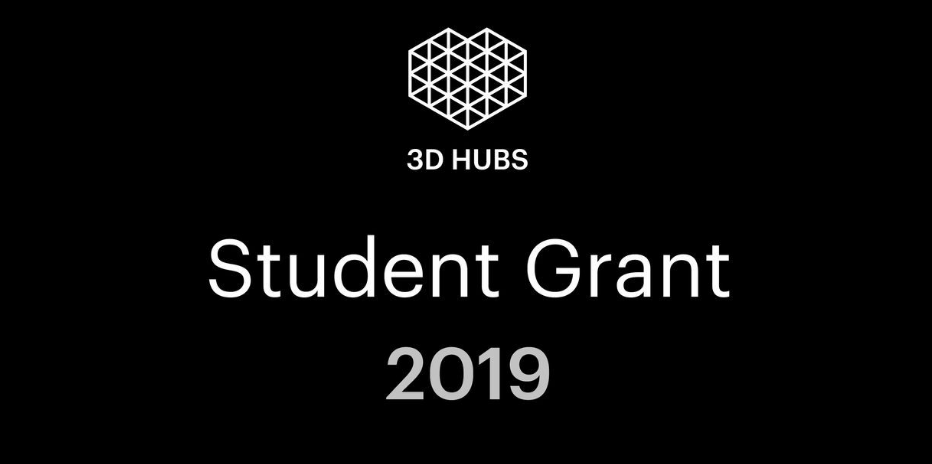
The winners have been announced in 3D Hubs’ 2019 Student Grant.
The contest has proven an interesting grounds over the past few years for discovering innovative designs from the next generation of designers. Previously covering three categories, for 2019 the contest opened up to cover five design areas:
-
Product Design
-
Robotics
-
Sustainability
-
Transportation
-
Healthcare
Launched this spring, the Student Grant has now announced its five winners from among an initial pool of almost 200 submissions put forth from more than 100 university and high school team and individual designers.
Competition was tough this year, as each of the five categories came down to a vote among the jury panel of impressive finalists. I can attest very directly to the stiff competition, as along with Chief Innovation Officer at BigRep and Managing Director of NOWLAB Daniel Buening, Ph.D and Director of Sales and Business Development at 3D Hubs and author of The 3D Printing Handbook Ben Redwood, Ph.D. I was on this year’s jury.
Each finalist presented a vision for a category-applicable entry that was voted on a private ballot, ensuring none of the other judges could influence choices. Scoring came down to each entry’s presentation (40%), their innovation and potential impact of their project (30%), and their justification of the use of 3D printing (30%).
Certain trends were interesting to see among the entries, as a large majority (72%) of submissions used FFF 3D printing, with SLA accounting for nearly a quarter, followed by SLS, DMLS, and PolyJet processes used less frequently. Many designs were created using SOLIDWORKS (33%) and Fusion 360 (28%), with Rhino, AutoCAD, and Grasshopper also proving relatively popular software choices.
Winners
The top prizes in each category are to be awarded $1,000 to help boost further concept development of these projects.
The highly popular Product Design category, which saw by far the most entries in this competition, proved a fertile ground for designers, who submitted nearly three-quarters of all Student Grant entries. Selection was so tight that rather than the five finalists planned and presented in the other categories, seven finalists were selected for the judges; two very close runners-up to the winner saw them named as Honorable Mentions in the final competition.
![Winner, Product Design: ONE Shoe [Image: 3D Hubs]](https://fabbaloo.com/wp-content/uploads/2020/05/1.-3D-Hubs-Student-Grant-Product-Design-Winner-ONE-Shoe1_img_5eb093d9df42d.jpg)
The final Product Design category winner is the ONE Shoe, submitted by Davide Amorim of the Eindhoven University of Technology (TU/e). The ONE Shoe applies Mechanical Meta-materials Structures (MMS) for a customized shoe that can be fully recycled. Honorable Mentions are Aero, by Ajharul Choudhury of Brunel University, and Thrive Wireless Valve Switch, by Seth Paulo Bangerter of Brigham Young University.
![Winner, Robotics: Teleport [Image: 3D Hubs]](https://fabbaloo.com/wp-content/uploads/2020/05/2.-3D-Hubs-Student-Grant-Robotics-Winner-Teleport1_img_5eb093da527a5.jpg)
In Robotics, the winning project comes from the University of California, Berkeley. Titled Teleport, the project used a partially 3D printed robot to allow hospitalized children the ability to “teleport” — to remotely visit, via a travelling robot and virtual reality, outside sites. It was developed by a team comprising Akhil Padmanabha, Rishi Upadhyay, Nicholas Liu, Steven Chen, and Samuel Chen.
![Winner, Sustainability: Recycling Wind Turbine Blade Fiberglass into Reinforced Filaments [Image: 3D Hubs]](https://fabbaloo.com/wp-content/uploads/2020/05/3.-3D-Hubs-Student-Grant-Sustainability-Winner-Recycling-Wind-Turbine-Blade-Fiberglass-into-Reinforced-Filaments1_img_5eb093daa97ba.jpg)
Sustainability saw top prize awarded to Amirmohammad Rahimizadeh’s project, Recycling Wind Turbine Blade Fiberglass into Reinforced Filaments, out of McGill University. This project seeks to do exactly as it is titled: use the material from wind turbine blades to create reinforced filament for 3D printing. Scrap blades can be reduced to glass fibers that tend to retain a significant amount of epoxy residue, which can be used to strengthen PLA.
![Winner, Transportation: Optimized Metallic Code-Connections for Reticulated Structures [Image: 3D Hubs]](https://fabbaloo.com/wp-content/uploads/2020/05/image-asset_img_5eb093db0578d.jpg)
Transportation’s winner, from the University of Leeds, brings metal into the forefront with Moustafa Abdelwahab’s entry, Optimized Metallic Code-Connections for Reticulated Structures. DMLS 3D printing can use natural inspiration for complex, freeform connection designs offering the benefits of geometric complexity, weight reduction, and high strength.
![Winner, Healthcare: ReCleft [Image: 3D Hubs]](https://fabbaloo.com/wp-content/uploads/2020/05/image-asset_img_5eb093db4b425.jpg)
Anatomy takes the prize for Healthcare, with the ReCleft project from Brunel University of London designed for cleft lip and/or palate (CLP) training. Rute Pereira Crespo Fiadeiro’s project uses PolyJet 3D printing to create specific silicone molds for cleft palate simulators to appropriately train healthcare providers on the delicacy of surgery options for the approximately 250,000 infants born with CLP each year in low-resource countries.
Next Generation Design
Altogether, the winning entries, honorable mentions, and finalists represent a strong showing of some of the next-generation designs from the next generation of designers.
All of the entries came from students currently enrolled in secondary, undergraduate or postgraduate education, or who recently graduated. Their use of advanced manufacturing technologies including 3D printing highlights the breadth of applications and is a testament to their education in these areas as design for additive manufacturing (DfAM) continues to be a major focus for Industry 4.0.
Via 3D Hubs











This week’s selection is a 3D printed Coronavirus!